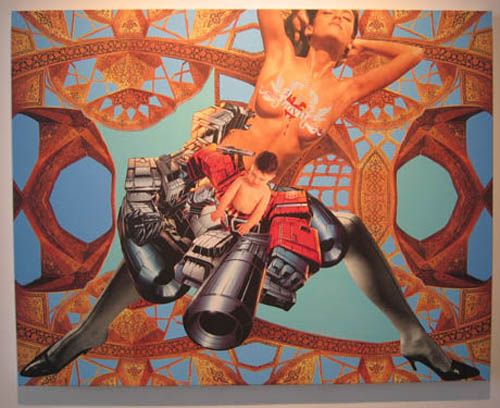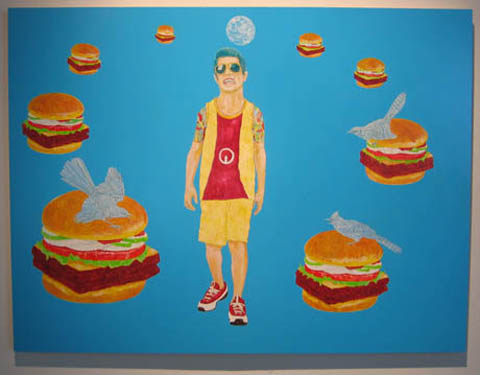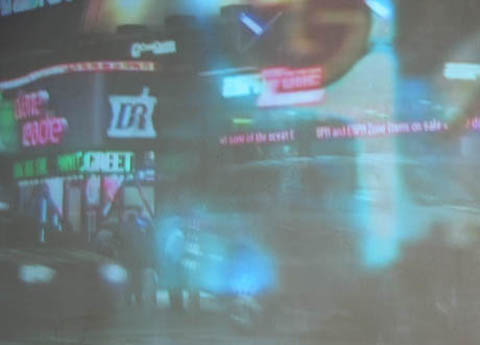I was curious to see what Jerry Kearns is up to. Almost twenty years ago, he was one of my professors at University of Massachusetts. He was the hip one, the one who commuted rom New York City to Amherst and back every week. Back then, he seemed to me to be a left-wing ideologue, always trying to get us to understand the social context of the work we were doing, but he was intelligent and worth arguing with, so I argued with him for two years in the sylvan forests of western Massachusetts.
Kearns' show splits neatly into three parts: a roomful of digital prints on canvas, a smaller roomful of hand-made paintings, and a music video.

Bird Nest, 2004-7
Kearns digital prints are dull compared with his paintings. Partly it's the medium. Digital printing on canvas is flat and lifeless compared to paint; what little zip these pictures have comes from their intense hand-painted blue backgrounds. It's too easy to recombine digital imagery, too easy to print yet another variation, and the repetition takes the oomph out of them. Juxtaposing Islamic architecture, cyber-droid fashion models and precocious techno-apocalypse babies the pieces rustle up a vaguely familiar East-West imperialist warmonger guilt, but they're impersonal, and lack punch. Kearns is using media to comment on media, but all the action takes place in a clean, computer generated architecture that's just too far from real life to get upset about.
The small room of real paintings is much better. Kearns has developed a dry coloring-book style he uses to translate, distort and combine photographic snippets, putting portraits of specific people into surreal, symbolic situations. It's essentially the same game, cutting up and rearranging photographs, but played for keeps. The bit of extra work it takes to hand paint these images is enough to preclude the aimless shilly-shallying of the digitally produced pieces.

Burger King, 2007
In Burger King, a grimacing man has a blocky head like Arnold Schwarzenegger and the limp, slacker body of Butthead. He slouches through a ring of orbiting double cheeseburgers. It's funny and curious in a way the digital pieces are not. Is he the all-consuming Californian governator, sporting a shirt with an inward-pointing arrow, striding forward, ready to consume the universe? He's got the teeth for it. The birds scold him for his hungry selfishness, since the Lorax is on vacation.

Rasta, 2001-2005
Rasta tackles more personal issues. A child-shaped figure with a big head and big blue sneakers strikes an aloof attitude as a bikini-wearing woman screams at him. Only his hair reacts, rising to form a frantic halo. A bulldog with a bird perched on his head looks on in sad-eyed, superior amusement. Is he her son, or her lover? Is the woman's scream joy or anger? Whatever she wants from him, he's not giving. I may be missing something since I don't recognize either of the faces, but even without recognition, Kearns' animated portraits make me wonder what's going on, and care.

Kearns' first-ever video piece, Killer Run, was a smooth ambient paean to New York street life. Gentle, slow-motion shots of signs, cabs, and people flow and dissolve into another to a sophisticated jazz soundtrack by Kearns' wife, singer/songwriter Nora York. The piece is unlike Kearns' disjointed, outspoken paintings, but years of pop image-hacking has given him the skill to edit a wonderfully appropriate, rhythmically flowing video collage. As in the best music videos, the low-key images have the good sense to provide symbiotic accompaniment to the polished sound, rather than insisting on an independent identity. The only glimpse we get of Kearns' pop irony is when the video lingers a moment on the MTV logo.



